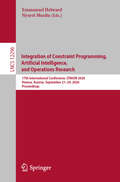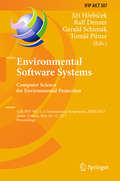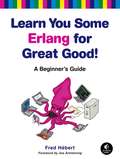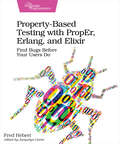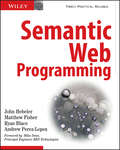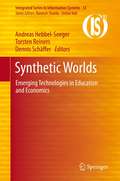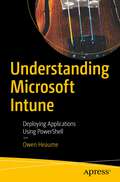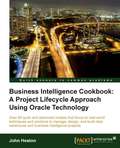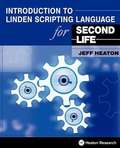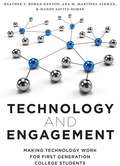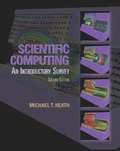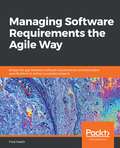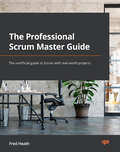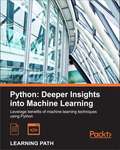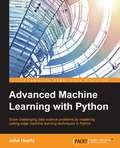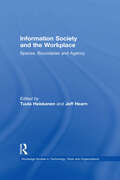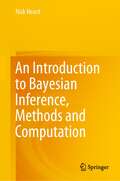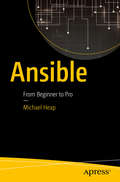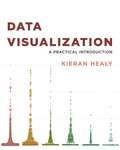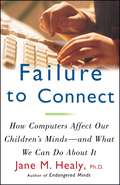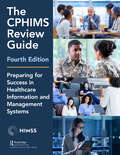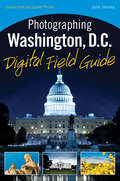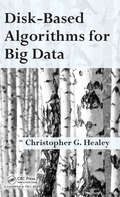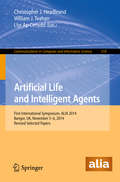- Table View
- List View
Integration of Constraint Programming, Artificial Intelligence, and Operations Research: 17th International Conference, CPAIOR 2020, Vienna, Austria, September 21–24, 2020, Proceedings (Lecture Notes in Computer Science #12296)
by Emmanuel Hebrard Nysret MusliuThe volume LNCS 12296 constitutes the papers of the 17th International Conference on the Integration of Constraint Programming, Artificial Intelligence, and Operations Research which will be held online in September 2020.The 32 regular papers presented together with 4 abstracts of fast-track papers were carefully reviewed and selected from a total of 72 submissions. Additionally, this volume includes the 4 abstracts and 2 invited papers by plenary speakers. The conference program also included a Master Class on the topic “Recent Advances in Optimization Paradigms and Solving Technology"
Environmental Software Systems. Computer Science for Environmental Protection: 12th Ifip Wg 5. 11 International Symposium, Isess 2017, Zadar, Croatia, May 10-12, 2017, Proceedings (IFIP Advances in Information and Communication Technology #507)
by Jiří Hřebíček Ralf Denzer Gerald Schimak Tomáš PitnerThis book constitutes the refereed proceedings of the 12th IFIP WG 5.11 International Symposium on Environmental Software Systems, ISESS 2017, held in Zadar, Croatia, in May 2017. The 35 revised full papers presented together with 4 keynote lectures were carefully reviewed and selected from 46 submissions. The papers deal with environmental challenges and try to provide solutions using forward-looking and leading-edge IT technology. They are organized in the following topical sections: air and climate; water and hydrosphere; health and biosphere; risk and disaster management; information systems; and modelling, visualization and decision support.
Learn You Some Erlang for Great Good!: A Beginner's Guide
by Fred HebertErlang is the language of choice for programmers who want to write robust, concurrent applications, but its strange syntax and functional design can intimidate the uninitiated. Luckily, there’s a new weapon in the battle against Erlang-phobia: Learn You Some Erlang for Great Good!Erlang maestro Fred Hébert starts slow and eases you into the basics: You’ll learn about Erlang’s unorthodox syntax, its data structures, its type system (or lack thereof!), and basic functional programming techniques. Once you’ve wrapped your head around the simple stuff, you’ll tackle the real meat-and-potatoes of the language: concurrency, distributed computing, hot code loading, and all the other dark magic that makes Erlang such a hot topic among today’s savvy developers.As you dive into Erlang’s functional fantasy world, you’ll learn about:–Testing your applications with EUnit and Common Test–Building and releasing your applications with the OTP framework–Passing messages, raising errors, and starting/stopping processes over many nodes–Storing and retrieving data using Mnesia and ETS–Network programming with TCP, UDP, and the inet module–The simple joys and potential pitfalls of writing distributed, concurrent applicationsPacked with lighthearted illustrations and just the right mix of offbeat and practical example programs, Learn You Some Erlang for Great Good! is the perfect entry point into the sometimes-crazy, always-thrilling world of Erlang.
Property-Based Testing with PropEr, Erlang, and Elixir: Find Bugs Before Your Users Do
by Fred HebertProperty-based testing helps you create better, more solid tests with little code. By using the PropEr framework in both Erlang and Elixir, this book teaches you how to automatically generate test cases, test stateful programs, and change how you design your software for more principled and reliable approaches. You will be able to better explore the problem space, validate the assumptions you make when coming up with program behavior, and expose unexpected weaknesses in your design. PropEr will even show you how to reproduce the bugs it found. With this book, you will be writing efficient property-based tests in no time. Most tests only demonstrate that the code behaves how the developer expected it to behave, and therefore carry the same blind spots as their authors when special conditions or edge cases show up. Learn how to see things differently with property tests written in PropEr. Start with the basics of property tests, such as writing stateless properties, and using the default generators to generate test cases automatically. More importantly, learn how to think in properties. Improve your properties, write custom data generators, and discover what your code can or cannot do. Learn when to use property tests and when to stick with example tests with real-world sample projects. Explore various testing approaches to find the one that's best for your code. Shrink failing test cases to their simpler expression to highlight exactly what breaks in your code, and generate highly relevant data through targeted properties. Uncover the trickiest bugs you can think of with nearly no code at all with two special types of properties based on state transitions and finite state machines. Write Erlang and Elixir properties that generate the most effective tests you'll see, whether they are unit tests or complex integration and system tests. What You Need Basic knowledge of Erlang, optionally ElixirFor Erlang tests: Erlang/OTP >= 20.0, with Rebar >= 3.4.0For Elixir tests: Erlang/OTP >= 20.0, Elixir >= 1.5.0
Semantic Web Programming
by John Hebeler Matthew Fisher Mike Dean Ryan Blace Andrew Perez-LopezThe next major advance in the Web?Web 3.0?will be built on semantic Web technologies, which will allow data to be shared and reused across application, enterprise, and community boundaries. Written by a team of highly experienced Web developers, this book explains examines how this powerful new technology can unify and fully leverage the ever-growing data, information, and services that are available on the Internet. Helpful examples demonstrate how to use the semantic Web to solve practical, real-world problems while you take a look at the set of design principles, collaborative working groups, and technologies that form the semantic Web. The companion Web site features full code, as well as a reference section, a FAQ section, a discussion forum, and a semantic blog.
Synthetic Worlds: Emerging Technologies in Education and Economics
by Andreas Hebbel-Seeger Dennis Schäffer Torsten ReinersSynthetic Worlds, Virtual Worlds, and Alternate Realities are all terms used to describe the phenomenon of computer-based, simulated environments in which users inhabit and interact via avatars. The best-known commercial applications are in the form of electronic gaming, and particularly in massively-multiplayer online role-playing games like World of Warcraft or Second Life. Less known, but possibly more important, is the rapid adoption of platforms in education and business, where Serious Games are being used for training purposes, and even Second Life is being used in many situations that formerly required travel. Linden Lab, creator of Second Life, recently announced the creation of Second Life Enterprise, with customers including IBM, Northrop Grumman, and the US Naval Undersea Warfare Center. The editors of this book captures the state of research in the field intended to reflect the rapidly growing yet relatively young market in education and business. The general focus is set on the scientific community but integrates the practical applications for businesses, with papers on information systems, business models, and economics. In six parts, international authors - all experts in their field - discuss the current state-of-the-art of virtual worlds/alternate realities and how the field will develop over the next years. Chapters discuss the influences and impacts in and around virtual worlds. Part four is about education, with a focus on learning environments and experiences, pedagogical models, and the effects on the different roles in the educational sector. The book looks at business models and how companies can participate in virtual worlds while receiving a return on investment, and includes cases and scenarios of integration, from design, implementation to application.
Understanding Microsoft Intune: Deploying Applications Using PowerShell
by Owen HeaumeLearn to deploy simple and complex applications that are beyond the scope of default Intune application deployment scenarios and limitations. This book will help you deploy applications using a PowerShell script. The book starts with PowerShell Cmdlets to get an understanding of deployment through PowerShell scripts. Next, you will learn how to work with msiexec where you will learn which properties of your MSI can be set and what values can be passed to them, even if you do not know what the properties and values initially are. Further, you will learn how to install and uninstall a Setup.exe and how to determine the silent switches, along with MSI extraction methods. You will then learn detection rules using PowerShell, including how to detect by registry or application version and build numbers as well as using custom PowerShell detection rules. You will then gain an understanding of the location to run the script. Moving forward, you will go through installing a program by calling MSI or Setup.exe using PowerShell and how to handle spaces in the filenames. Following this, you will go through how to deploy the various script types in Intune; whether it is a standard script, or if the whole script is a function or contains functions, or if it has an entry point. Deployment Templates and application preparation in Intune are discussed next, along with the process to create the .Intunewin with the Intune Winapp Util. You will then learn how to uninstall previous applications before a new deployment. You'll also be walked through useful snippets and examples of deployment where you will be able to utilize all the aspects of deployment in Intune discussed in prior chapters. After reading the book, you will be able to manage application deployments and detection rules using PowerShell with Microsoft Intune.What You Will Learn:How to find valid properties and values to use with msiexecUsing PowerShell for detection ruleDeploying using a template for reliable and repeatable deploymentsHow to create the Windows App (Win32) App Who Is This Book For:I.T Professionals who manage application deployments using Microsoft Intune.
Business Intelligence: A Project Lifecycle Approach Using Oracle Technology Cookbook
by John HeatonThis book is written in a simple, easy to understand format with lots of screenshots and step-by-step explanations. If you are Project Managers or IT professionals looking to design and develop a data warehouse and business intelligence solution, then this is the best guide for you. This book assumes that you have a fundamental knowledge of data warehouse and business intelligence projects.
Introduction to Linden Scripting Language for Second Life
by Jeff HeatonThe Linden Scripting Language allows residents of the Second Life World to program the three dimensional objects around them. Without this programming objects built in Second Life are motionless and non-interactive. Adding a script enables an object to interact with the world around it. Second Life scripts allow objects such as cars, planes, amusement park rides, weapons and other entertainment devices to be created. This book teaches the beginning Second Life programmer to make use of the basics of the Linden Scripting Language. Language fundamentals, such as variables, loops, lists, events, functions and state machines are covered. The book then moves to more advanced topics such as user interaction and non-physical movement. Later chapters show how to use the Second Life physics engine to create vehicles.
Technology and Engagement: Making Technology Work for First Generation College Students
by Heather T. Rowan-Kenyon Ana M. Martínez Alemán Mandy Savitz-RomerTechnology and Engagement is based on a four-year study of how first generation college students use social media, aimed at improving their transition to and engagement with their university. Through web technology, including social media sites, students were better able to maintain close ties with family and friends from home, as well as engage more with social and academic programs at their university. This ‘ecology of transition’ was important in keeping the students focused on why they were in college, and helped them become more integrated into the university setting. By showing the gains in campus capital these first-generation college students obtained through social media, the authors offer concrete suggestions for how other universities and college-retention programs can utilize the findings to increase their own retention of first-generation college students.
Scientific Computing: An Introductory Survey
by Michael T. HeathThis book presents a broad overview of numerical methods for solving all the major problems in scientific computing.
Managing Software Requirements the Agile Way: Bridge the gap between software requirements and executable specifications to deliver successful projects
by Fred HeathLearn how to deliver software that meets your clients' needs with the help of a structured, end-to-end methodology for managing software requirements and building suitable systems Key Features Learn how to communicate with a project's stakeholders to elicit software requirements Deal every phase of the requirement life cycle with pragmatic methods and techniques Manage the software development process and deliver verified requirements using Scrum and Kanban Book Description Difficulty in accurately capturing and managing requirements is the most common cause of software project failure. Learning how to analyze and model requirements and produce specifications that are connected to working code is the single most fundamental step that you can take toward project success. This book focuses on a delineated and structured methodology that will help you analyze requirements and write comprehensive, verifiable specifications. You'll start by learning about the different entities in the requirements domain and how to discover them based on customer input. You'll then explore tried-and-tested methods such as impact mapping and behavior-driven development (BDD), along with new techniques such as D3 and feature-first development. This book takes you through the process of modeling customer requirements as impact maps and writing them as executable specifications. You'll also understand how to organize and prioritize project tasks using Agile frameworks, such as Kanban and Scrum, and verify specifications against the delivered code. Finally, you'll see how to start implementing the requirements management methodology in a real-life scenario. By the end of this book, you'll be able to model and manage requirements to create executable specifications that will help you deliver successful software projects. What you will learn Kick-start the requirements-gathering and analysis process in your first meeting with the client Accurately define system behavior as features Model and describe requirement entities using Impact Mapping and BDD Create a feature-based product backlog and use it to drive software development Write verification code to turn features into executable specifications Deliver the right software and respond to change using either Scrum or Kanban Choose appropriate software tools to provide transparency and traceability to your clients Who this book is for This book is for software engineers, business analysts, product managers, project managers, and software project stakeholders looking to learn a variety of techniques and methodologies for collating accurate software requirements. A fundamental understanding of the software development life cycle (SDLC) is needed to get started with this book. Although not necessary, basic knowledge of the Agile philosophy and practices, such as Scrum, along with some programming experience will help you to get the most out of this book.
The Professional Scrum Master (PSM I) Guide: Successfully practice Scrum with real-world projects and achieve your PSM I certification with confidence
by Fred HeathGo from absolute beginner to passing your PSM I exam first time with this comprehensive guide. Packed with practical examples, this book is updated for the latest Scrum guidelines to turn you into a Scrum Master!Key FeaturesGo from absolute beginner to exam-ready with detailed explorations of Scrum use-casesUnderstand the different applications of agile concepts, and how to best apply them to your businessDiscover expert tips and work with real-world examples to pass the PSM I certification exam first timeBook DescriptionEver wondered why you'd use Scrum over other process frameworks? Or what makes Agile just so agile? Or why you should bother with the PSM certification? This book has you covered.The Professional Scrum Master (PSM I) Guide is a comprehensive tutorial that will not only introduce you to the basics of Scrum, but build you up to be ready to pass your PSM I exam first time round. Where other books avoid detail, this guide provides you with detailed practical examples to take you from being an apprentice to becoming a master.Assuming you're a total beginner, this book will introduce you to Scrum methodologies with detailed use cases, teaching you the secrets of Scrum in such a way that you'll be well-equipped for the PSM I exam.This book demonstrates the real-world applications of Scrum in a variety of scenarios, all with practical examples.You'll understand why the structure of your Scrum team matters, what you can achieve with properly planned sprints, and how to create and manage sprint and product backlogs. The chapters are regularly concluded with quizzes relevant to the exam, reinforcing the values you learn on your journey. Finally, it concludes with some exam preparation and myth-dispelling to make sure you have an edge when it comes to earning your certificate. This is a guide that'll ensure you won't fall behind in an ever increasingly agile world.What you will learnGet to grips with Agile development and Scrum from the ground upUnderstand the roles and responsibilities within the Scrum teamDiscover how to conduct Scrum events and create Scrum artifactsExplore real-world scenarios and use cases for Scrum in actionDevelop an in-depth understanding of how to run a successful sprint to deliver results quicklyBe fully prepared and able to pass your PSM I exam first timeWho this book is forAssuming no prior knowledge of Scrum, this book is for professionals who want to build a strong foundation in Scrum practices with the intention of passing the PSM I exam. If you're a product owner or project manager looking to stay relevant in an agile world, this book is essential to helping you become a Scrum Master.
Python: Deeper Insights into Machine Learning
by John Hearty David Julian Sebastian RaschkaLeverage benefits of machine learning techniques using Python About This Book * Improve and optimise machine learning systems using effective strategies. * Develop a strategy to deal with a large amount of data. * Use of Python code for implementing a range of machine learning algorithms and techniques. Who This Book Is For This title is for data scientist and researchers who are already into the field of data science and want to see machine learning in action and explore its real-world application. Prior knowledge of Python programming and mathematics is must with basic knowledge of machine learning concepts. What You Will Learn * Learn to write clean and elegant Python code that will optimize the strength of your algorithms * Uncover hidden patterns and structures in data with clustering * Improve accuracy and consistency of results using powerful feature engineering techniques * Gain practical and theoretical understanding of cutting-edge deep learning algorithms * Solve unique tasks by building models * Get grips on the machine learning design process In Detail Machine learning and predictive analytics are becoming one of the key strategies for unlocking growth in a challenging contemporary marketplace. It is one of the fastest growing trends in modern computing, and everyone wants to get into the field of machine learning. In order to obtain sufficient recognition in this field, one must be able to understand and design a machine learning system that serves the needs of a project. The idea is to prepare a learning path that will help you to tackle the real-world complexities of modern machine learning with innovative and cutting-edge techniques. Also, it will give you a solid foundation in the machine learning design process, and enable you to build customized machine learning models to solve unique problems. The course begins with getting your Python fundamentals nailed down. It focuses on answering the right questions that cove a wide range of powerful Python libraries, including scikit-learn Theano and Keras.After getting familiar with Python core concepts, it's time to dive into the field of data science. You will further gain a solid foundation on the machine learning design and also learn to customize models for solving problems. At a later stage, you will get a grip on more advanced techniques and acquire a broad set of powerful skills in the area of feature selection and feature engineering. Style and approach This course includes all the resources that will help you jump into the data science field with Python. The aim is to walk through the elements of Python covering powerful machine learning libraries. This course will explain important machine learning models in a step-by-step manner. Each topic is well explained with real-world applications with detailed guidance.Through this comprehensive guide, you will be able to explore machine learning techniques.
Advanced Machine Learning with Python
by John HeartySolve challenging data science problems by mastering cutting-edge machine learning techniques in Python About This Book * Resolve complex machine learning problems and explore deep learning * Learn to use Python code for implementing a range of machine learning algorithms and techniques * A practical tutorial that tackles real-world computing problems through a rigorous and effective approach Who This Book Is For This title is for Python developers and analysts or data scientists who are looking to add to their existing skills by accessing some of the most powerful recent trends in data science. If you've ever considered building your own image or text-tagging solution, or of entering a Kaggle contest for instance, this book is for you! Prior experience of Python and grounding in some of the core concepts of machine learning would be helpful. What You Will Learn * Compete with top data scientists by gaining a practical and theoretical understanding of cutting-edge deep learning algorithms * Apply your new found skills to solve real problems, through clearly-explained code for every technique and test * Automate large sets of complex data and overcome time-consuming practical challenges * Improve the accuracy of models and your existing input data using powerful feature engineering techniques * Use multiple learning techniques together to improve the consistency of results * Understand the hidden structure of datasets using a range of unsupervised techniques * Gain insight into how the experts solve challenging data problems with an effective, iterative, and validation-focused approach * Improve the effectiveness of your deep learning models further by using powerful ensembling techniques to strap multiple models together In Detail Designed to take you on a guided tour of the most relevant and powerful machine learning techniques in use today by top data scientists, this book is just what you need to push your Python algorithms to maximum potential. Clear examples and detailed code samples demonstrate deep learning techniques, semi-supervised learning, and more - all whilst working with real-world applications that include image, music, text, and financial data. The machine learning techniques covered in this book are at the forefront of commercial practice. They are applicable now for the first time in contexts such as image recognition, NLP and web search, computational creativity, and commercial/financial data modeling. Deep Learning algorithms and ensembles of models are in use by data scientists at top tech and digital companies, but the skills needed to apply them successfully, while in high demand, are still scarce. This book is designed to take the reader on a guided tour of the most relevant and powerful machine learning techniques. Clear descriptions of how techniques work and detailed code examples demonstrate deep learning techniques, semi-supervised learning and more, in real world applications. We will also learn about NumPy and Theano. By this end of this book, you will learn a set of advanced Machine Learning techniques and acquire a broad set of powerful skills in the area of feature selection & feature engineering. Style and approach This book focuses on clarifying the theory and code behind complex algorithms to make them practical, useable, and well-understood. Each topic is described with real-world applications, providing both broad contextual coverage and detailed guidance.
Search User Interfaces
by Marti A. HearstThe truly world-wide reach of the Web has brought with it a new realisation of the enormous importance of usability and user interface design. In the last ten years, much has become understood about what works in search interfaces from a usability perspective, and what does not. Researchers and practitioners have developed a wide range of innovative interface ideas, but only the most broadly acceptable make their way into major web search engines. This book summarizes these developments, presenting the state of the art of search interface design, both in academic research and in deployment in commercial systems. Many books describe the algorithms behind search engines and information retrieval systems, but the unique focus of this book is specifically on the user interface. It will be welcomed by industry professionals who design systems that use search interfaces as well as graduate students and academic researchers who investigate information systems.
Information Society and the Workplace: Spaces, Boundaries and Agency (Routledge Studies in Technology, Work and Organizations #Vol. 1)
by Jeff Hearn Tuula HeiskanenMuch has been written on the grand prospects for "Information Society"; much less on what this might mean in everyday terms. So what do we find when we look at what is happening in a society, Finland, that is one of closest to an information society? Bringing together studies of everyday local practices in workplaces within information society, this book has a special focus on social space and the agency of actors. It includes both theoretical reviews and detailed qualitative research. It also highlights the political challenges of the information society, challenges which are likely to become subjects of international concern.
An Introduction to Bayesian Inference, Methods and Computation
by Nick HeardThese lecture notes provide a rapid, accessible introduction to Bayesian statistical methods. The course covers the fundamental philosophy and principles of Bayesian inference, including the reasoning behind the prior/likelihood model construction synonymous with Bayesian methods, through to advanced topics such as nonparametrics, Gaussian processes and latent factor models. These advanced modelling techniques can easily be applied using computer code samples written in Python and Stan which are integrated into the main text. Importantly, the reader will learn methods for assessing model fit, and to choose between rival modelling approaches.
Ansible: From Beginner to Pro
by Michael HeapThis book is your concise guide to Ansible, the simple way to automate apps and IT infrastructure. In less than 250 pages, this book takes you from knowing nothing about configuration management to understanding how to use Ansible in a professional setting. You will learn how to create an Ansible playbook to automatically set up an environment, ready to install an open source project. You'll extract common tasks into roles that you can reuse across all your projects, and build your infrastructure on top of existing open source roles and modules that are available for you to use. You will learn to build your own modules to perform actions specific to your business. By the end you will create an entire cluster of virtualized machines, all of which have your applications and all their dependencies installed automatically. Finally, you'll test your Ansible playbooks. Ansible can do as much or as little as you want it to. Ansible: From Beginner to Pro will teach you the key skills you need to be an Ansible professional. You'll be writing roles and modules and creating entire environments without human intervention in no time at all - add it to your library today. What You Will Learn Learn why Ansible is so popular and how to download and install it Create a playbook that automatically downloads and installs a popular open source project Use open source roles to complete common tasks, and write your own specific to your business Extend Ansible by writing your own modules Test your infrastructure using Test Kitchen and ServerSpec Who This Book Is For Developers that currently create development and production environments by hand. If you find yourself running apt-get install regularly, this book is for you. Ansible adds reproducibility and saves you time all at once. Ansible: From Beginner to Pro is great for any developer wanting to enhance their skillset and learn new tools.
Data Visualization: A Practical Introduction
by Kieran HealyThis book provides students and researchers a hands-on introduction to the principles and practice of data visualization. It explains what makes some graphs succeed while others fail, how to make high-quality figures from data using powerful and reproducible methods, and how to think about data visualization in an honest and effective way. Data Visualization builds the reader’s expertise in ggplot2, a versatile visualization library for the R programming language. Through a series of worked examples, this accessible primer then demonstrates how to create plots piece by piece, beginning with summaries of single variables and moving on to more complex graphics. Topics include plotting continuous and categorical variables; layering information on graphics; producing effective “small multiple” plots; grouping, summarizing, and transforming data for plotting; creating maps; working with the output of statistical models; and refining plots to make them more comprehensible. Effective graphics are essential to communicating ideas and a great way to better understand data. This book provides the practical skills students and practitioners need to visualize quantitative data and get the most out of their research findings. Provides hands-on instruction using R and ggplot2 Shows how the “tidyverse” of data analysis tools makes working with R easier and more consistent Includes a library of data sets, code, and functions
Failure to Connect: How Computers Affect Our Children's Minds and What We Can Do About It
by Jane M. HealyIn this comprehensive, practical, and unsettling look at computers in children's lives, Jane M. Healy, Ph.D., questions whether computers are really helping or harming children's development. Once a bedazzled enthusiast of educational computing but now a troubled skeptic, Dr. Healy examines the advantages and drawbacks of computer use for kids at home and school, exploring its effects on children's health, creativity, brain development, and social and emotional growth. Today, the Federal Government allocates scarce educational funding to wire every classroom to the Internet, software companies churn out "educational" computer programs even for preschoolers, and school administrators cut funding and space for books, the arts, and physical education to make room for new computer hardware. It is past the time to address these issues. Many parents and even some educators have been sold on the idea that computer literacy is as important as reading and math. Those who haven't hopped on the techno bandwagon are left wondering whether they are shortchanging their children's education or their students' futures. Few people stop to consider that computers, used incorrectly, may do far more harm than good. New technologies can be valuable educational tools when used in age-appropriate ways by properly trained teachers. But too often schools budget insufficiently for teacher training and technical support. Likewise, studies suggest that few parents know how to properly assist children's computer learning; much computer time at home may be wasted time, drawing children away from other developmentally important activities such as reading, hobbies, or creative play. Moreover, Dr. Healy finds that much so-called learning software is more "edutainment" than educational, teaching students more about impulsively pointing and clicking for some trivial goal than about how to think, to communicate, to imagine, or to solve problems. Some software, used without careful supervision, may also have the potential to interrupt a child's internal motivation to learn. Failure to Connect is the first book to link children's technology use to important new findings about stages of child development and brain maturation, which are clearly explained throughout. It illustrates, through dozens of concrete examples and guidelines, how computers can be used successfully with children of different age groups as supplements to classroom curricula, as research tools, or in family projects. Dr. Healy issues strong warnings, however, against too early computer use, recommending little or no exposure before age seven, when the brain is primed to take on more abstract challenges. She also lists resources for reliable reviews of child-oriented software, suggests questions parents should ask when their children are using computers in school, and discusses when and how to manage computer use at home. Finally, she offers a thoughtful look at the question of which skills today's children will really need for success in a technological future -- and how they may best acquire them. Based on years of research into learning and hundreds of hours of interviews and observations with school administrators, teachers, parents, and students, Failure to Connect is a timely and eye-opening examination of the central questions we must confront as technology increasingly influences the way we educate our children.
The CPHIMS Review Guide, 4th Edition: Preparing for Success in Healthcare Information and Management Systems (HIMSS Book Series)
by Healthcare Information & Management Systems Society (HIMSS)Whether you’re taking the CPHIMS exam or simply want the most current and comprehensive overview in healthcare information and management systems today, this completely revised and updated fourth edition has it all. But for those preparing for the CPHIMS exam, this book is also an ideal study partner. The content reflects the outline of exam topics covering healthcare and technology environments; clinical informatics; analysis, design, selection, implementation, support, maintenance, testing, evaluation, privacy and security; and management and leadership. Candidates can challenge themselves with the sample multiple-choice questions given at the end of the book. The benefits of CPHIMS certification are broad and far-reaching. Certification is a process that is embraced in many industries, including healthcare information and technology. CPHIMS is recognized as the ‘gold standard’ in healthcare IT because it is developed by HIMSS, has a global focus and is valued by clinicians and non-clinicians, management and staff positions and technical and nontechnical individuals. Certification, specifically CPHIMS certification, provides a means by which employers can evaluate potential new hires, analyze job performance, evaluate employees, market IT services and motivate employees to enhance their skills and knowledge. Certification also provides employers with the evidence that the certificate holders have demonstrated an established level of job-related knowledge, skills and abilities and are competent practitioners of healthcare IT.
Photographing Washington, D.C. Digital Field Guide
by John HealeyThe ideal companion guide for capturing awe-inspiring photos of Washington, D. C. ! Whether using a compact camera or a high-end dSLR, this companion guide provides you with detailed information for taking spectacular shots of some of the most recognizable architecture in the world. Whether you aim to capture memorable photos of the White House, U. S. Capitol, Washington Monument, Lincoln Memorial, or one of D. C. 's other many remarkable memorials, this portable resource goes where you go and walks you through valuable tips and techniques for taking the best shot possible. You'll discover suggested locations for taking photos, recommended equipment, what camera settings to use, best times of day to photograph specific attractions, how to handle weather challenges, and more. In addition, beautiful images of Washington, D. C. 's most breathtaking attractions and recognizable landmarks serve to both inspire and assist you as you embark on an amazing photographic adventure! Elevates your photography skills to a new level with photography secrets from professional photographer John Healey Presents clear, understandable tips and techniques that span all skill levels, using all types of digital cameras, from compact cameras to high end DSLRs Features Washington, D. C. 's main attractions in alphabetical order as well as thumb tabs on the pages so you can quickly and easily access the information you are looking for Shares detailed information and insight on critical topics, such as ideal locations to photograph from, the best time of day to shoot, camera equipment to have handy, weather conditions, and optimal camera settings to consider Whether you're a local familiar with the territory or a visitor seeing our nation's capital for the first time, this handy guide will help capture fantastic photos!
Disk-Based Algorithms for Big Data
by Christopher G. HealeyDisk-Based Algorithms for Big Data is a product of recent advances in the areas of big data, data analytics, and the underlying file systems and data management algorithms used to support the storage and analysis of massive data collections. The book discusses hard disks and their impact on data management, since Hard Disk Drives continue to be common in large data clusters. It also explores ways to store and retrieve data though primary and secondary indices. This includes a review of different in-memory sorting and searching algorithms that build a foundation for more sophisticated on-disk approaches like mergesort, B-trees, and extendible hashing. Following this introduction, the book transitions to more recent topics, including advanced storage technologies like solid-state drives and holographic storage; peer-to-peer (P2P) communication; large file systems and query languages like Hadoop/HDFS, Hive, Cassandra, and Presto; and NoSQL databases like Neo4j for graph structures and MongoDB for unstructured document data. Designed for senior undergraduate and graduate students, as well as professionals, this book is useful for anyone interested in understanding the foundations and advances in big data storage and management, and big data analytics. About the Author Dr. Christopher G. Healey is a tenured Professor in the Department of Computer Science and the Goodnight Distinguished Professor of Analytics in the Institute for Advanced Analytics, both at North Carolina State University in Raleigh, North Carolina. He has published over 50 articles in major journals and conferences in the areas of visualization, visual and data analytics, computer graphics, and artificial intelligence. He is a recipient of the National Science Foundation’s CAREER Early Faculty Development Award and the North Carolina State University Outstanding Instructor Award. He is a Senior Member of the Association for Computing Machinery (ACM) and the Institute of Electrical and Electronics Engineers (IEEE), and an Associate Editor of ACM Transaction on Applied Perception, the leading worldwide journal on the application of human perception to issues in computer science.
Artificial Life and Intelligent Agents: First International Symposium, ALIA 2014, Bangor, UK, November 5-6, 2014. Revised Selected Papers (Communications in Computer and Information Science #519)
by Christopher J. Headleand William J. Teahan Llyr Ap CenyddThis book constitutes the refereed proceedings of the First International Symposium on Artificial Life and Intelligent Agents, ALIA 2014, held in Bangor, UK, in November 2014. The 10 revised full papers were carefully reviewed and selected from 20 submissions. The papers are organized in topical sections on learning and evolution; human interaction; robotic simulation.
